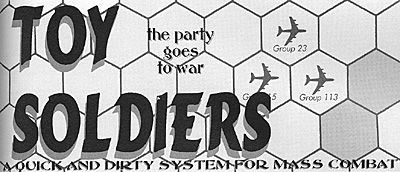 Introduction
Introduction
What do you do when your fantasy campaign turns to the business of war? For those of you who are not wargamers, the process might seem a little murky at best. This article is for those people who aren't interested in converting a large clunky miniatures system to their own game to resolve a few small skirmishes.
Wargamer or not, one thing must be clear: what you're about to read does not constitute a real wargame. Please use this system to describe things as they exist in your role-playing game campaign. While the cost system can be used to invent battles from scratch, this system has not been minimax proofed, which is to say there are laughable loopholes through which sly garners can drive a truck through. Don't let the tail wag the dog: use this system to describe the troops you've already determined are part of a RPG campaign scenario (if you do want to use it to plan a battle from scratch, employ a solid dose of common sense).
To utilize "Toy Soldiers: The Party Goes to War," you will need the following materials: a table-top, cardstock in several light colors, non-smearing pens in at least two colors, several rulers, scissors (don't run with 'em!), ten-sided dice, and photocopies of the relevant charts from this article. Optional materials include a hex map with one inch hexes (either paper or re-usable vinyl), actual soldier-type miniatures, big sheets of newsprint, and anything else you can think of that adds "fun" to the mix.
What kind of battles does this system address? Small to medium-sized battles. The unit scale is approximately 50-150 soldiers per unit. The time scale, per turn, is flexible: at the beginning of a battle, when units are posturing and moving around for position, time might be passing in the game at anywhere from 15 to 60 minutes per turn. When things heat up, and units are in the midst of combat, turns might become much shorter, as few as several minutes per turn. As you will hear again and again, running a battle scene will require a bit of fudging by the GM!
war is physical politics
War is nothing more than politics dealt out at the point of a sword. That having been said, let's also remember that this is a fantasy situation, and you must be willing to suspend a certain amount of disbelief when it comes to the whys and wherefores of a fantasy war.
The prequel to war is important. Don't drop a war on your players without some warm-up. A look at any significant war in recent world history provides plenty of examples of what goes on before war. While Pearl Harbor may have been a surprise, there was plenty of posturing beforehand: Japan had been making war in Asia for several years, and the US finally felt threatened enough to issue an ultimatum: cool it or else.
Whatever happens before a battle, be sure that it is an ominous sequence of events. Involving the player characters is an option that shouldn't be ignored. For example, what if the PC's spark a war with some thoughtless actions near a border? What if they are taunted into providing such an excuse for war by a belligerent lord or lady?
Don't forget that no one begins a war without some goal in mind. Sure, that goal may be unclear or poorly thought out, but war is expensive and it isn't engaged in just to pass the time. The goal of a belligerent may change during the course of a war. Keep this goal in mind when determining victory conditions.
Toy Soldiers Quick and Dirty System for Mass Combat
Back to Shadis #49 Table of Contents
Back to Shadis List of Issues
Back to MagWeb Master List of Magazines
© Copyright 1998 by Alderac Entertainment Group
This article appears in MagWeb.com (Magazine Web) on the Internet World Wide Web.
Other military history articles and gaming articles are available at http://www.magweb.com